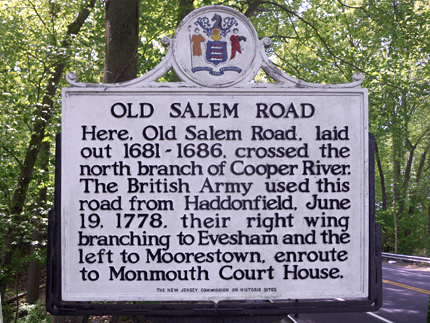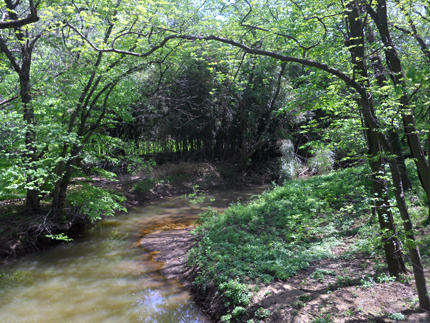



Cherry Hill Monument
Outside Cherry Hill Mall
Near the Main Entrance between Macy's and the North Face
Map / Directions to the Cherry Hill Monument
This boulder was placed inside the mall at its opening in 1961. It was later moved outside around 2007. [1] It pays tribute to the role the surrounding area played in the Revolutionary War era. [2]
The monument briefly mentions several Revolutionary War events. More detailed descriptions and clarifications of these events are given below:
British forces occupied Philadelphia from September 26, 1777 until June 18, 1778. On October 21, 1777, the British sent Hessian troops from Philadelphia to attack Fort Mercer, an American Fort on the Delaware River in what is now National Park. (Hessians were German mercenary soldiers hired by the British to fight in the Revolutionary War.)
The Hessians crossed the Delaware River from Philadelphia into New Jersey, landing in Cooper's Ferry (now Camden). They marched to Haddonfield, where they camped for the night. The following morning, they marched southwest towards Fort Mercer. In order to reach Fort Mercer, the Hessians needed to get across the Big Timber Creek at some point. They marched to a bridge in what is now Brooklawn but discovered that the bridge there had been dismantled by American forces. This caused the Hessians to march an additional eight to ten miles and cross the Big Timber Creek at the Clement's Road Bridge.
Later that day, the Hessians made their attack on Fort Mercer, in what became known as the Battle of Red Bank, where they were defeated, and returned to Philadelphia the following day, crossing back over the Delaware River from Cooper's Ferry. The site of Fort Mercer is now Red Bank Historical Park. See the National Park page of this website for details about the battle and the park. [3]
The Battle of Gloucester referred to on the boulder was a skirmish that occurred on November 25, 1777. (The boulder incorrectly states "March of 1777.") It was the first battlefield command of the Marquis de Lafayette, a French officer who fought for the Americans in the Revolutionary War.
Major General Nathanael Greene sent George Washington the following description of the skirmish:
(Greene's original spelling and punctuation have been left unchanged. "Picquet" refers to a picket, a small group of soldiers placed in front of a main force, to warn against attack)"The Marquis with about 400 Militia & the rifle Corps, attacked the enemies Picquet last evening, kill’d about 20 & wounded many more & took about 20 prisoners—the Marquis is charmed with the spirited behaviour of the Militia & Rifle Corps—they drove the enemy above half a mile & kept this ground untill dark—the enemy’s picquet consisted of about 300 & were reinforced during the skirmish—The Marquis is determined to be in the way of danger." [4]
In February, the British forces occupying Philadelphia were in need of food for their troops and for their horses. They planned a large foraging expedition into this part of New Jersey to collect cattle and hay. General Washington, then with his army at Valley Forge, Pennsylvania, received word of this plan, and he sent General "Mad Anthony" Wayne to this area to take away cattle and destroy hay before the British got there.
On February 25, General Wayne was in Haddonfield, from where he wrote to General Washington that he had collected and sent on 150 head of cattle, and that he had burned quantities of hay to keep it from the British.
General William Howe, in command of the British at Philadelphia, got word of Wayne's activities and ordered thousands of troops across the Delaware River into New Jersey to cut Wayne off. About 2000 British soldiers under Colonel Sterling and Major John Simcoe marched to Haddonfield. Wayne received advance warning of this, and because he was greatly outnumbered (his own forces totaled about 500, including 300 militia) he evacuated Haddonfield to Mount Holly before the British troops arrived.
Wayne sent a request for assistance to General Pulaski, who commanded a group of cavalry. Pulaski met up with Wayne in Mount Holly with about fifty cavalry to reinforce Wayne's strength, and they headed towards Haddonfield. Upon hearing that Wayne would be returning to Haddonfield with Pulaski's cavalry, British troops evacuated the town and retreated to Cooper's Ferry, where they skirmished with Wayne and Pulaski's men before crossing the Delaware River back to Philadelphia on March 2.
Wayne and Pulaski's forces had been largely successful in preventing the British from capturing food. They carried only about fifty-six head of cattle with them back to Philadelphia. [5]
"Here, Old Salem Road, laid out 1681 – 1686, crossed the north branch of Cooper River."

Old Salem Road Marker
Brace Rd. / where it crosses over the Cooper River
Map / Directions to the Old Salem Road MarkerBritish and Hessian troops occupied Philadelphia from September 26, 1777 until June 18, 1778. When they left Philadelphia, they crossed the Delaware River into Cooper's Ferry (now Camden). From there, they marched across New Jersey to New York City, which was occupied by the British for almost the entire war and was their main base of operations.
This historic marker notes that this road was once part of Old Salem Road, which the British used in part of their march. As noted on the sign, the troops next split into two wings, one encamping at Evesham (now Mount Laurel) and the other to Moorestown.
Washington's army, who had spent the previous six months at Valley Forge, Pennsylvania, crossed into New Jersey at Coryell's Ferry on June 20, and marched in pursuit of the British troops, keeping a path miles to the north of them. The two armies met at Monmouth Court House, where they fought the Battle of Monmouth on June 28, 1778. [6]
1. ^ Information obtained in phone and email communication with Anne Ford, Office Manager at Cherry Hill Mall, May 2015
2. ^ This area was not known as Cherry Hill at the time of the Revolutionary War. The township took the name Cherry Hill in 1961. It had previously been known as Delaware Township since 1844. The name "Cherry Hill" derived from a 19th-century farm which was located in the area where the mall is today. The events described on the monument relate to areas surrounding what is now Cherry Hill township, not just within its borders.
For information about the history of Cherry Hill, see:
• History of Cherry Hill article, available as a PDF on the Cherry Hill Township website here
• John F. Snyder, The Story of New Jersey's Civil Boundaries: 1606-1968 (Trenton: Bureau of Geology and Topography, 1969) Pages 104-105
Available as a PDF on the State of New Jersey website here. (Note that although the information is on pages numbered 104-105 of the document, it is on pages 111-112 of the PDF file.)3. ^ Samuel Stelle Smith, Fight for the Delaware, 1777 (Monmouth Beach, N.J.: Philip Freneau Press, 1970) Pages 18-23.
This includes the map on page 20, which traces the route taken by the Hessian troops. The book states that the map was "based largely on the extensive road research of Mr. Harry Marvin of Mullica Hill, N.J."
▸ The map is also reproduced on the "Fort Mercer is Attacked" sign at the Red Bank Historical Park• For more information about the events mentioned in this paragraph, see the town pages linked from within the text.
4. ^ • “To George Washington from Major General Nathanael Greene, 26 November 1777,” Founders Online, National Archives (http://founders.archives.gov/documents/Washington/03-12-02-0404 [last update: 2015-03-20]). Source: The Papers of George Washington, Revolutionary War Series, vol. 12, 26 October 1777 – 25 December 1777, ed. Frank E. Grizzard, Jr. and David R. Hoth. Charlottesville: University Press of Virginia, 2002, pp. 408–411.
• For Lafayette's own account of the Battle of Gloucester, see:
“To George Washington from Major General Lafayette, 26 November 1777,” Founders Online, National Archives (http://founders.archives.gov/documents/Washington/03-12-02-0408 [last update: 2015-03-20]). Source: The Papers of George Washington, Revolutionary War Series, vol. 12, 26 October 1777 – 25 December 1777, ed. Frank E. Grizzard, Jr. and David R. Hoth. Charlottesville: University Press of Virginia, 2002, pp. 417–420.• For a Hessian soldier's account, see:
Johann Conrad Döhla, Bruce E. Burgoyne, editor and translator, A Hessian Diary of the American Revolution (Norman, OK: University of Oklahoma Press, 1993) Pages 60-61
Available to be read at Google Books here5. ^ • “To George Washington from Brigadier General Anthony Wayne, 25 February 1778,” Founders Online, National Archives (http://founders.archives.gov/documents/Washington/03-13-02-0566 [last update: 2015-03-20]). Source: The Papers of George Washington, Revolutionary War Series, vol. 13, 26 December 1777 – 28 February 1778, ed. Edward G. Lengel. Charlottesville: University of Virginia Press, 2003, pp. 668–671.
• “To George Washington from Brigadier General Anthony Wayne, 26 February 1778,” Founders Online, National Archives (http://founders.archives.gov/documents/Washington/03-13-02-0575 [last update: 2015-03-20]). Source: The Papers of George Washington, Revolutionary War Series, vol. 13, 26 December 1777 – 28 February 1778, ed. Edward G. Lengel. Charlottesville: University of Virginia Press, 2003, pp. 677–678.
• “From George Washington to Brigadier General Anthony Wayne, 28 February 1778,” Founders Online, National Archives (http://founders.archives.gov/documents/Washington/03-13-02-0601 [last update: 2015-03-20]). Source: The Papers of George Washington, Revolutionary War Series, vol. 13, 26 December 1777 – 28 February 1778, ed. Edward G. Lengel. Charlottesville: University of Virginia Press, 2003, pp. 700–701.
• “From George Washington to Brigadier General Anthony Wayne, 2 March 1778,” Founders Online, National Archives (http://founders.archives.gov/documents/Washington/03-14-02-0027 [last update: 2015-03-20]). Source: The Papers of George Washington, Revolutionary War Series, vol. 14, 1 March 1778 – 30 April 1778, ed. David R. Hoth. Charlottesville: University of Virginia Press, 2004, p. 42.
• “To George Washington from Brigadier General Anthony Wayne, 5 March 1778,” Founders Online, National Archives (http://founders.archives.gov/documents/Washington/03-14-02-0056 [last update: 2015-03-20]). Source: The Papers of George Washington, Revolutionary War Series, vol. 14, 1 March 1778 – 30 April 1778, ed. David R. Hoth. Charlottesville: University of Virginia Press, 2004, pp. 72–75.
• New Jersey Gazette No. 14, Mar 4, 1778, reprinted in:
Francis B. Lee, editor, Archives of the State of New Jersey, Second Series, Vol II (Documents Relating to the Revolutionary History of the State of New Jersey | Extracts from American Newspapers relating to New Jersey) (Trenton: John L. Murphy Publishing Company, 1903) page 91
Available to be read at Google Books here• "A Correspondent Desires Us to Insert The Following" New Jersey Gazette No. 15, Mar 11, 1778, reprinted in:
Francis B. Lee, editor, Archives of the State of New Jersey, Second Series, Vol II (Documents Relating to the Revolutionary History of the State of New Jersey | Extracts from American Newspapers relating to New Jersey) (Trenton: John L. Murphy Publishing Company, 1903) page 101-102
Available to be read at Google Books here• John Graves Simcoe, Simcoe's Military Journal (New York: Bartlett & Welford, 1844) Pages 38-46
Available to be read at Google Books here
6. ^ This sign erected by the New Jersey Commission on Historic Sites
• For more information and accompanying source notes about the other locations mentioned in this entry, see the pages link from within the text.